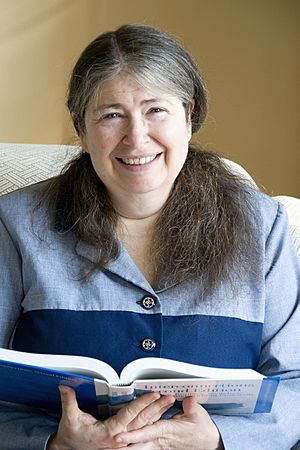Radia Perlman facts for kids
Quick facts for kids
Radia Perlman
|
|
|---|---|

Perlman in 2009
|
|
| Born | December 18, 1951 |
| Alma mater | MIT |
| Known for | Network and security protocols; computer books |
| Scientific career | |
| Fields | Computer Science |
| Institutions | Intel |
| Thesis | Network layer protocols with Byzantine robustness (1988) |
| Doctoral advisor | David D. Clark |
Radia Joy Perlman (born December 18, 1951) is an American computer programmer and network engineer. She is a very important person in building the technology that created the Internet. Because of her work, she is sometimes called the "Mother of the Internet."
Perlman is most famous for inventing the Spanning Tree Protocol (STP). This protocol is a set of rules that helps computer networks run smoothly. It prevents network meltdowns by finding and blocking extra, confusing paths for data. Her work has had a huge impact on how networks organize themselves and send information. She also improved many other parts of network design, making them stronger and easier to manage.
For her amazing contributions, Perlman has received many honors. She was elected to the National Academy of Engineering in 2019. She has also been added to the Internet Hall of Fame and the National Inventors Hall of Fame.
Contents
Early Life and Education
Radia Perlman was born in Portsmouth, Virginia, and grew up in New Jersey. Both of her parents were engineers for the U.S. government. Her father worked on radar, and her mother was a mathematician and computer programmer.
In school, math and science came easily to Perlman. She also enjoyed playing the piano and French horn. Even though she was the best math and science student at her school, she didn't think about a career with computers until she took a programming class in high school. She was the only girl in the class.
College Years at MIT
Perlman went to the Massachusetts Institute of Technology (MIT) for college. There, she was one of only about 50 women in a class of 1,000 students. At first, this felt normal to her. It was only when she saw other women in a crowd of men that she thought it looked a little strange.
At MIT, she got her first paid job programming for the LOGO Lab. She helped create a kid-friendly version of the LOGO programming language. This language was used to control a small robot called a Turtle. Perlman was a pioneer in teaching young children how to code.
She earned two degrees in Mathematics and later a Ph.D. in Computer Science from MIT. Her final research project, or thesis, was about making computer networks that could still work even if parts of them were attacked or failed. This work became the foundation for many modern security ideas.
Career and Major Inventions
After college, Perlman started working for a company called Digital Equipment Corporation (DEC) in 1980. It was here that she had her biggest breakthrough.
The Spanning Tree Protocol (STP)
In 1984, Perlman's boss gave her a challenge: create a simple way to stop computer networks from crashing. At the time, if a network had extra connections (called redundant links), it could create a "loop." A loop would cause data to circle around forever, flooding the network and causing it to fail.
Perlman came up with a brilliant solution in just a few days. She created the Spanning Tree Protocol (STP). STP allows networks to have backup paths for safety, but it cleverly turns off any extra paths that could cause a loop. This leaves just one clear, active path for data to travel between any two points on the network.
Thanks to STP, networks became much more reliable. Perlman even wrote a short poem, called "Algorhyme," to explain how it works:
I think that I shall never see
A graph more lovely than a tree.
A tree whose crucial property
Is loop-free connectivity.
A tree which must be sure to span
So packets can reach every LAN.
First the root must be selected.
By ID it is elected.
Least cost paths from root are traced.
In the tree these paths are placed.
A mesh is made by folks like me
Then bridges find a spanning tree.—Radia Perlman
Other Important Work
Perlman didn't stop with STP. She helped design many other important network protocols. Protocols are like the rules of the road for data on the internet. She helped improve how data is routed, or sent, across large networks. Her work made networks faster and more adaptable to changes.
She has written popular textbooks about networking and network security that are used in colleges around the world. Over her career, she has earned more than 100 patents for her inventions.
More recently, she invented a new protocol called TRILL. TRILL is an improvement on her original STP and helps modern networks use their connections even more efficiently. She also wrote a second poem to describe this new idea.
Awards and Recognition
Radia Perlman's work has earned her many awards. Here are some of them:
- National Inventors Hall of Fame induction (2016)
- Internet Hall of Fame induction (2014)
- SIGCOMM Award (2010)
- USENIX Lifetime Achievement Award (2006)
- Recipient of the first Anita Borg Institute Women of Vision Award for Innovation in 2005
- Silicon Valley Intellectual Property Law Association Inventor of the year (2003)
See also
 In Spanish: Radia Perlman para niños
In Spanish: Radia Perlman para niños

